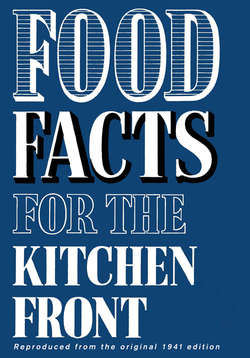Читать книгу Food Facts for the Kitchen Front - Литагент HarperCollins USD, Ю. Д. Земенков, Koostaja: Ajakiri New Scientist - Страница 5
ОглавлениеA NOTE ON FOOD FACTORS
THOUGH we cannot expect to become scientific experts overnight, it is useful for us to learn something about calories, proteins, vitamins and mineral salts. We ought to know what they are and what they do to our bodies.
CALORIES
Calories are units of heat, which we liberate in our body-tissues when we eat Energy Foods (Starches, Fats and Sugar). Our daily caloric requirement varies according to our sex and occupation. Men need more calories than women do. People whose work calls for great physical activity need more calories than are required by sedentary workers.
PROTEINS
Food is a mixture of chemical substances, and the chemical constituent known as protein builds our muscles and tissues. Proteins are therefore particularly important to growing children.
Animal proteins are derived from the main body-building foods: Meat, Fish, Eggs, Milk and Cheese. Vegetable proteins are obtained from our “second line of defence”:
Oatmeal.
Wheatmeal Bread.
Potatoes.
Green Vegetables.
Dried Peas, Beans and Lentils.
VITAMINS
Vitamins are food factors necessary to growth and nourishment.
Their existence was discovered when scientific research proved that artificial food mixtures (containing all the known nutritive factors in a purified state) were unable to support growth without the addition of a natural food, such as milk.
It was obvious then that natural foods must contain unknown essential food factors. These are now known as vitamins. The most important are Vitamins A, B and C.
Vitamin A plays an important part in building up our resistance to infection. It is essential for the adapting of the eye to sudden changes of light. “Night blindness” may be due to a deficiency of Vitamin A.
Good sources of this vitamin are Spinach, Carrots, Cabbage, Peas and Beans. Halibut liver oil and Cod liver oil, Herrings, Margarine.
Vitamin B is essential for the correct functioning of the nervous system, which influences our digestive system.
Good sources of the vitamin are Wheatmeal Bread and Flour, Oatmeal, Vegetable Extract.
Vitamin C maintains the correct structure of the tissue of the blood-vessels. Complete absence of this vitamin from the diet leads to scurvy.
Good sources of the vitamin are Potatoes, Green Vegetables (especially raw), Root Vegetables (especially raw) and Fruit.
Vitamin values are expressed, not in ounces nor grammes but in International Units. Since our daily requirement of Vitamin A is taken as about 5,000 International Units, we may find it useful to remember that:
I oz. Carrots contains 540 International Units of Vitamin A.
I oz. Boiled Cabbage contains 356 International Units of Vitamin A.
By eating half a pound of carrots and four ounces of cabbage we should almost have satisfied our total daily requirement.
Our daily requirement of Vitamin B is much smaller. It is taken as 500 International Units. Here we may find it useful to remember that:
I oz. Oatmeal contains 92 International Units of Vitamin B.
I oz. Wheatmeal Bread contains 28 International Units of Vitamin B.
By eating four ounces of oatmeal and four ounces of wheatmeal bread we should again be very near the figure of our total daily requirement.
Our daily requirement of Vitamin C is taken as 1,250 International Units.
Here we may find it useful to remember that:
I oz. Potatoes contains from 105–140 International Units of Vitamin C.
I oz. Boiled Cabbage contains 95 International Units of Vitamin C.
By eating half a pound of potatoes and a quarter of a pound of cabbage we can satisfy our total daily requirement of Vitamin C.
MINERAL SALTS
Iron and Calcium.—We should be careful to guard against a deficiency of Iron in our foods. Iron is an element of great importance in the body, specially to women and girls, who need it to safeguard them against tiredness and anaemia.
Good sources of Iron are Wheatmeal Bread, Oatmeal, Watercress and Spinach.
Calcium is necessary to our bodies for building bones and teeth. This naturally means that it is of great importance to growing children, to expectant and nursing mothers.
Good sources of Calcium are Milk and Green Vegetables.
